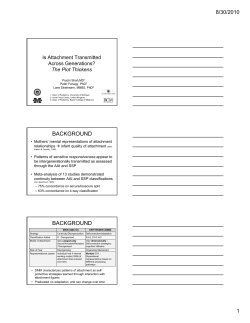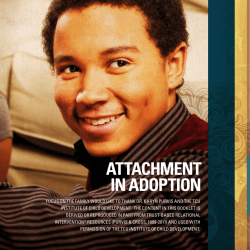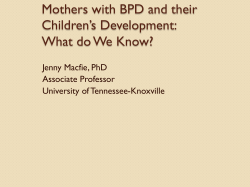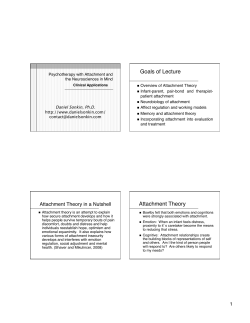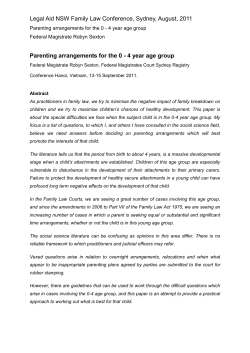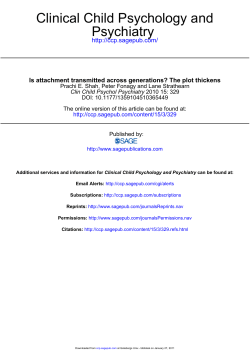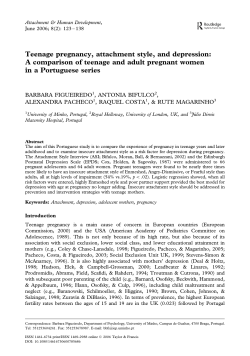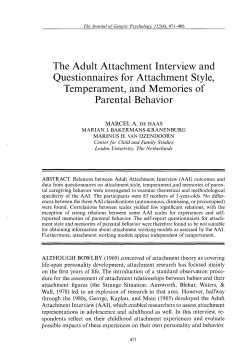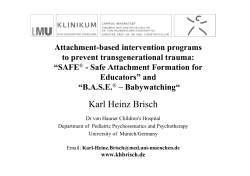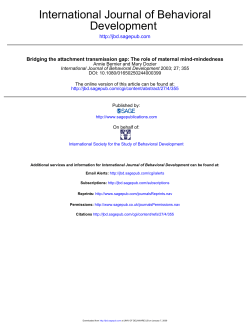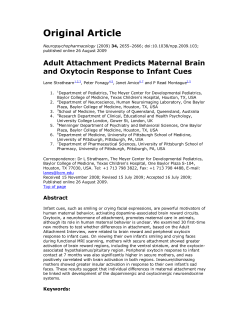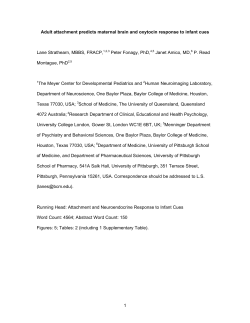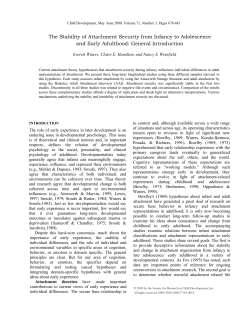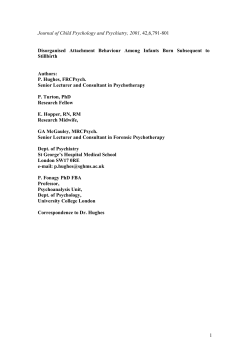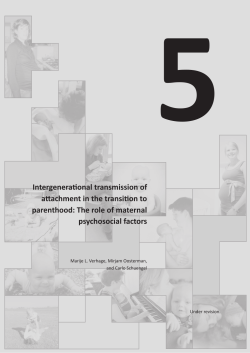
Transmission of attachment across three generations: Continuity and reversal Article
Article Transmission of attachment across three generations: Continuity and reversal Clinical Child Psychology and Psychiatry 15(3) 347–354 © The Author(s) 2010 Reprints and permission: sagepub. co.uk/journalsPermissions.nav DOI: 10.1177/1359104510365451 ccp.sagepub.com Airi Hautamäki,1 Laura Hautamäki,1 Leena Neuvonen,2 and Sinikka Maliniemi-Piispanen3 Abstract We followed a normative Finnish sample of primiparous mothers, fathers, and maternal grandmothers from pregnancy until the child was 3 years old (N = 32 families). The Adult Attachment Interview (AAI) was used to assess attachment in mothers, fathers and grandmothers during the last trimester of the mother’s pregnancy. The Preschool Assessment of Attachment (PAA) was used to assess attachment in children at 3 years. Forty-seven percent of the 32 grandmother–mother–infant triads had the corresponding attachment classifications. Using EXACON for the analysis of single cells of 3 × 3 contingency tables with type-antitype classifications, and frequency tabulation of the major three-generation combinations, both triads indicating continuity across three generations (B/B/B 22% and A/A/A 19%) and reversal reactions (A/C/A and C/A/C 22%) were found. The results indicated continuity across three generations for Type B and for Type A and alternations from A to C and vice versa for insecure attachment. We discuss the implications of these findings for theory development and clinical work. Keywords Adult Attachment Interview, attachment, Preschool Assessment of Attachment, three generations, transmission In this brief report, we analyze data across three generations from grandmothers to mothers to grandchildren in a Finnish sample. Like Shah, Fonagy, and Strathearn (2010) and Crittenden, Partridge, and Claussen (1991), we found that a model of both secure matches and insecure meshes from one generation to the next fits better than a model of only matches. Studies using the Infant Strange Situation Procedure (SSP, Ainsworth, Blehar, Waters, & Wall, 1978) and the Adult Attachment Interview (AAI, Main, Kaplan, & Cassidy, 1985), have documented correspondence between mothers’ AAI classifications and children’s SSP classifications 1 University of Helsinki, Finland Child Psychologist, Finland 3 Psychologist and Psychoanalytic Psychotherapist in private practice, Finland 2 Corresponding author: Airi Hautamäki, Swedish School of Social Science, P.O.B. 16, FIN-00014 University of Helsinki. E-mail: airi.hautamaki@helsinki.fi 348 Clinical Child Psychology and Psychiatry 15(3) retrospectively (Van IJzendoorn, 1995), concurrently (Van IJzendoorn, Kranenburg, Zwart-Woudstra, van Bussbach, & Lambermon, 1991), and prospectively (Fonagy, Steele, & Steele, 1991). Benoit and Parker (1994) reported intergenerational match between grandmothers’ and mothers’ AAI classifications, and 1-year-old infants’ SSP classification with the mother. Continuity of quality of attachment across generations can be explained in terms of stability of the family environment (Lamb, Thompson, Gardner, & Charnov, 1985). Because the greatest stability is found in middle-class, stable samples, continuity may be partly a function of socioeconomic context which may permit a less dangerous and stressful family environment (Crittenden, 2008). For example, the secure classifications in Benoit and Parker’s (1994) sample accounted for almost all of the variance. Correspondingly, lawful discontinuity of attachment from infancy to adulthood is related to environmental change (Weinfield, Sroufe, & Egeland, 2000). The DynamicMaturational Model (DMM) of attachment and adaptation addresses change, treating adaptation as the dynamic fit of strategy to context, that is the relation of strategy to parental contingencies and contextual dangers (Crittenden, 2008). That is, early conditions are not seen as defining or limiting individual potential; rather the effect of maturation is to create possibilities for change in developmental pathways. When there is danger, the DMM predicts increasingly complex organizations both across individuals’ development and across generations (Crittenden, 2008). This study reports additional findings from the study by Hautamäki, Hautamäki, Neuvonen, and Maliniemi-Piispanen (in press). In that study, we found that Type B and to some extent Type A tended to be stable across three generations. In this brief report, we add findings regarding couples’ attachment and change in triadic patterns from grandmothers to mothers to grandchildren. Methods Subjects and procedures Criteria for inclusion in the study were that the mother had a partner, was expecting her first child, was at least 18 years old, and that the maternal grandmother agreed to participate in the study. Volunteer samples were enrolled through maternity counseling offices that provide service to all expectant mothers in Finland. Thirteen couples with maternal grandmothers were recruited from a middle-sized town in eastern Finland and 19 from Helsinki. Healthcare nurses gave all expectant mothers a written description of the study and invited them to participate. The total sample consisted of 32 mothers, their spouses, maternal grandmothers, and firstborn children. None of the grandmothers lived with their daughters. The sample reflected relatively stable middle-class backgrounds. The infants were full-term, healthy newborns. Forty-one percent were male. The educational level of the mothers was higher than that of their mothers (74.3% of mothers compared to 27.3% of grandmothers had university degrees; χ2 = 15.8, df = 2, p < .001). For further data on the sample, see Hautamäki, et al., in press). After obtaining informed consent, the interviews were completed in the subjects’ homes during the expectant mother’s third trimester of pregnancy. Other visits were made during the next three years and then the child’s attachment was assessed at three years. Assessments The Preschool Assessment of Attachment (PAA) was used to assess attachment at three years (Farnfield, Hautamäki, Nørbech, & Sahhar, 2010). The PAAs were coded by two coders trained by Crittenden. Inter-rater reliability was 95 percent for major categories. Two children received a Hautamäki et al. 349 C3–4 classification; all the others fit the Ainsworth ABC patterns. The 3-category A-B-C was used in the analyses with the two C3–4 children included in the C category. The Modified Adult Attachment Interview (AAI) was used to assess the mothers’, fathers’, and grandmothers’ dispositional representations with regard to attachment (Farnfield et al., 2010). The transcripts were coded by two Finnish coders who were trained by Crittenden. Agreement between the two coders was 92% (for grandmothers), 83% (for mothers), and 91% (for fathers) on AAI major categories. Results Distributions Although the sample was drawn from a normative population, the distribution of the attachment patterns was tilted toward Type A; this was particularly pronounced for the fathers (64.7%), children at the age of 3 (51.5%), and to some extent for the grandmothers (42.4%). There was a lower frequency of Type B attachments as compared to Anglo samples: grandmothers = 24.2%, mothers = 32.4%, fathers = 17.6%, and children at 3 years = 27.3% (Hautamäki et al., in press). Grandmother, mother, child attachment Forty-seven percent of the 32 grandmother–mother–infant triads had the corresponding attachment classifications. Mothers’ AAI classifications during pregnancy predicted the 3-year-old children’s PAA classifications in 58% of cases. Grandmothers’ AAI classifications predicted the 3-year-old grandchildren’s PAA classifications in 72% of cases. The frequencies of the 32 grandmother– mother–child triads are given in Table 1 in accordance with Benoit and Parker (1994). In Table 1, frequencies and percentages (%a) for Type A, B and C children within grandmother and mother combinations are presented, as well as the distribution of all data combined in percentages (%b), and a ratio of %a/%b. Table 1 indicates that the prediction of the child’s attachment classification improved when both the mother’s and the grandmother’s attachment classifications were known. Compared to the expected rate of Type A child outcomes (51%), infants of Type A mothers and grandmothers were 1.7 times (86%) more likely to be classified as avoidant. Compared to the expected rate of Type B child outcomes (27%), children of Type B mothers and grandmothers were 3.7 times (100%) more likely to be classified as secure. The Type C matrilineal line resulted either in the Type A child outcome (3 children, expected rate = 51%, observed rate = 60%), or alternatively, Type C children (2 children, expected rate = 21%, observed rate = 40%). The highest level of continuity was linked to Types B and A (Hautamäki, et al., in press). Additionally, a pendulum swing, from Type A (grandmothers) to Type C (mothers), and back to Type A again (children) was found. Compared to the expected rate of Type A children (51%), children of Type C mothers and grandchildren of Type A grandmothers were two times more likely to be classified as Type A. Because of secure matches and insecure meshes (that is, reversals within anxious attachment across generations), the maternal grandmother’s attachment pattern more often corresponded to that of her grandchild than did the mother’s. The grandmother–grandchild association was analyzed with Bergman and El-Khouri’s (2002) EXACON, a FORTRAN 77 program for the exact analysis of single cells in a contingency table for two categorical variables. With EXACON correct probabilities can be obtained for small expected cell frequencies (Bergman & El-Khouri, 1987). The 3 × 3 table (Table 2) presents observed and expected frequencies, hyperbolic probabilities and type/antitype classifications (χ2 = 23.9, 350 Clinical Child Psychology and Psychiatry 15(3) Table 1. Children’s 3-category attachment classifications using the PAA at 3 years: actual rates, base rates, and ratio of actual/base rates (N = 32) Grandmother Mother Child f %a %b Ratio A A A B C A B C A B C A B C A B C A B C A B C A B C A B C 6 0 1 0 0 1 6 0 0 1 0 0 0 7 0 0 0 0 1 0 1 0 2 1 3 0 2 86 0 14 0 0 100 100 0 0 100 0 0 0 100 0 0 0 0 50 0 50 0 66 33 60 0 40 51 27 21 51 27 21 51 27 21 51 27 21 51 27 21 51 27 21 51 27 21 51 27 21 51 27 21 1.7 less 0.6 less less 4.8 2.0 less less 2.0 less less less 3.7 less less less less 1.0 less 2.4 less 2.4 1.6 1.2 less 1.9 B C B A B C C A B C Notes: f = frequency; %a = observed distribution; %b = base rate of children, 3-year-old (N = 32); ratio = actual/base. df = 4, contingency coefficient = .65). Table 2 indicates that the Type B and A matrilineal lines showed continuity from grandmother to grandchild. The C line was less continuous, only marginally significant. For grandmothers using a Type A strategy Type B grandchildren were an antitype and for grandmothers using a Type B strategy Type A grandchildren were an antitype. Table 3 presents the frequencies of the major grandmother–mother–child combinations. The most frequent three-generation triads were B/B/B and A/A/A indicating continuity, and A/C/A and C/A/C indicating reversal. The A/C/A combination was more frequent than C/A/C. The frequency of other combinations was low (0–3). The emergence of ‘new’ Type B mothers seemed to be related to Type C grandmothers. Seven of 11 Type B mothers originated from Type B grandmothers, three from Type C grandmothers and one from a Type A grandmother. Couples’ attachment. Father–mother correspondences were analyzed with the χ2 Test, coupled with Bergman and El-Khouri’s (2002) EXACON. There were 11 matches (five A/A, four B/B and two C/C combinations), 12 meshes (A/C & C/A), and nine secure/insecure combinations, but none of these were significant according to the cell-wise analysis. There was no significant relation between mothers’ 351 Hautamäki et al. Table 2. Cross-tabulation of the attachment classifications of grandmothers and grandchildren using EXACON (N = 32) Grandmother/grandchild A observed expected p type/antitype B observed expected p type/antitype C observed expected p type/antitype All children A B C All grandmothers Odds-ratio 12 7,4 .002 type 0 3,9 .002 antitype 2 2,6 .46 14 15,6 1 4,3 .01 antitype 7 2,3 .001 type 0 1,5 .15 8 77 4 5,3 .27 2 2,8 .41 4 1,9 .06 10 6,7 17 9 6 32 Notes: observed from grandmother-child data, expected calculated with EXACON, p = hyperbolic probability for a cell, type = observed > expected, antitype = observed < expected, given that p < .05.Odds-ratio for AA line, BB line and CC line calculated from 2 x 2 tables using formula or = ad/bc. Table 3. Major combinations (f, %) of the attachment classifications across three generations (N = 32) Combination f % B/B/B A/C/A or C/A/C A/A/A Others Total 7 7 6 12 32 22 22 19 37 100 and fathers’ AAI classifications. Fathers more often used a Type A strategy and were less frequently secure than mothers (Hautamäki, in press). Were the B/B matches between spouses less frequent for this reason? Discussion A complex model of intergenerational transmission of attachment. A model of secure matches and insecure meshes accounted for transmission of attachment across three generations when the children were 3 years of age. Specifically, there was continuity across three generations for Type B, as predicted. The increased skew toward the largest classification in this study (Type A) may increase stability as a statistical artifact. In addition, reversal patterning (meshing) could be seen across generations for Types A and C. Because this has now been found in three very different samples (Crittenden et al., 1991; Shah et al., 2010), we think it warrants serious consideration. 352 Clinical Child Psychology and Psychiatry 15(3) We think this can be explained by the fact that Types A and C are psychologically opposite strategies. The focus of individuals using them is on different aspects of the incoming signal, that is on temporal order for Type A or intensity of stimulation for Type C (Crittenden, 2008). Particularly children of parents with high-subscript attachment classifications, that is A3–8 and C3–8, may have to organize in a reverse way to the parents’ pattern. In this study, high-subscript classifications were more frequent among the grandmothers – many of whom had lived through World War II. When parents have experienced danger and developed more extreme attachment strategies to protect themselves, their way of caring for their children may create a threat to their child, who has to organize his attachment strategy around this threat. An easily angered and abusive mother may elicit a compulsive compliant strategy in her child. Alternatively, a depressed and withdrawn mother may elicit a compulsive caretaking strategy in her child, who in her turn may not be capable of restraining anger in her own child and, thus, may raise a child who uses a Type C strategy (Crittenden, 2008). In our data, low-subscript anxious strategies also produced reversals. It appeared that children developed a strategy that fit the mother’s expectations by contributing a “missing” piece to the information processing of their mother. For example, a mother using a Type A strategy who wanted to be more available and express her feelings more openly than her parents may not able to establish an authority relationship, only prioritizing the child’s perspective, thus, encouraging her child to use a Type C strategy. In this study, the children’s attachment classifications were also associated with those of their fathers, who may have had an influential role in their children’s turn at the age of 3 toward avoidant attachment. In Finland, bringing up even young children is today also the responsibility of the fathers (Hautamäki, in press). Couples’ attachment In our middle-class, normative sample of couples, various matches, meshes, and secure–insecure combinations were found, but none of them were significant. An earlier study using the Main and Goldwyn (1984–1994) method on a maltreating sample indicated that matches would be dominant among secure partners, and both likes and opposites would attract equally among insecure partners (Crittenden et al., 1991). Future studies should explore whether coding method or sample risk status can explain the difference. However, the low rate of matches in this study may indicate a potential of misunderstanding between partners who process attachment-related information very differently ultimately resulting in a crush of conflicting needs and intense feelings (Crittenden et al., 1991). This mismatch in expectations and behavior in the couple relationship may invite to triangulations involving the child on the level of the family system. Clinical implications These findings, together with those of Shah and Crittenden and their colleagues (Crittenden et al., 1991; Shah et al., 2010), suggest that in troubled dyads, mothers and their children often frame experience in opposite ways and act on the basis of opposite representations. If mothers were not aware of this, it would be difficult for them to elicit the responses they desire from their children. On the contrary, they might feel that their children behaved in particularly exasperating and unexpected ways. Similarly, spouses often used opposite psychological strategies to organize their behavior. As with children, well-meaning responses could backfire, producing unintended conflict and distress. This could also occur if professionals treated dyads and couples as sharing a single strategy when they did not, thus, intervening in ways that unexpectedly augmented problems. Hautamäki et al. 353 When mother–child dyads and couples come to treatment, it might be helpful for professionals to be aware of the meshing effect and to assess for it. Where it was found, one aspect of the intervention could be to enable the adults (mothers and partners) to recognize the strategy used by the other person, thus expanding their own representational framework, and to use the new information to organize a more adaptive response. Rather than activating the strategy of the child or partner, the more integrative response would emphasize points of agreement while respecting individual differences. It is important to note that accomplishing this is equivalent to reorganizing in the direction of Type B and will yield greater security for both dyads and couples. Limitations and directions for future research Because the sample is small, this study is more exploratory than confirmatory, and the results should be generalized with caution. Small-scale longitudinal attachment studies use time-consuming in-depth attachment assessments that require extensive training. Cross-cultural attachment research rarely produces representative demographic data (Van IJzendoorn & Sagi, 1999). A future research question is to specify the model of secure matches and insecure meshes across generations. This question could be answered by a reanalysis of data from previously published samples, testing for the combined matches and meshes effect. Acknowledgments This research was supported by the Academy of Finland, University of Joensuu, and University of Helsinki. We would also like to thank the participants in the study. References Ainsworth, M.D.S., Blehar, M.C., Waters, E., & Wall, S. (1978). Patterns of attachment: A psychological study of the strange situation. Hillsdale, NJ: Lawrence Erlbaum. Benoit, D., & Parker, K. (1994). Stability and transmission of attachment across three generations. Child Development, 65, 1444–1456. Bergman, L.R., & El-Khouri, B. (1987). EXACON – A FORTRAN 77 Program for the exact analysis of single cells in a contingency table. Educational and Psychological Measurement, 47, 155–161. Bergman, L.R., & El-Khouri, B. (2002). SLEIPNER – a statistical package for pattern-oriented analyses. Department of Psychology, Stockholm University, loaded 2.1.2002. Crittenden, P.M. (2008). Raising parents: Attachment, parenting, and child safety. Collumpton, UK: Willan. Crittenden, P.M., Partridge, M.F., & Claussen, A.H. (1991). Family patterns of relationship in normative and dysfunctional families. Development and Psychopathology, 3, 491–512. Farnfield, S., Hautamäki, A., Nørbech, P., & Sahhar, N. (2010). DMM assessments of attachment and adaptation: Procedures, validity and utility. Clinical Child Psychology and Psychiatry, 15(3), 313–328. Fonagy, P., Steele, H., & Steele, M. (1991). Maternal representations of attachment during pregnancy predict the organization of infant–mother attachment at one year of age. Child Development, 62, 891–905. Hautamäki, A. (in press). Attachment and parental sensitivity in a low-risk Finnish sample – the avoidant and unresponsive Finns? In P. Aunio, M. Jahnukainen, M. Kalland, & J. Silvonen (Eds.), Piaget is dead, Vygotsky is still alive, or Essays in Honour of Professors Airi and Jarkko Hautamäki. Finnish Educational Research Association: Research in Educational Sciences. Hautamäki, A., Hautamäki, L., Neuvonen, L., & Maliniemi-Piispanen, S. (in press). The transmission of attachment across three generations. European Journal of Developmental Psychology. 354 Clinical Child Psychology and Psychiatry 15(3) Lamb, M.E., Thompson, R.A., Gardner, W.P., & Charnov, E.L. (1985). Infant–mother attachment: The origins and developmental significance of individual differences in Strange Situation behavior. Hillsdale, NJ: Erlbaum. Main, M., & Goldwyn, R. (1984–1994). Adult attachment scoring and classification system. Unpublished manuscript, University of California at Berkeley, Department of Psychology. Main, M., Kaplan, N., & Cassidy, J. (1985). Seurity in infancy, childhood and adulthood: A move to the level of representation. Monographs of the Society for Research in Child Development, 50(1–2, Serial No. 209). Shah, P.E., Fonagy, P., & Strathearn, L. (2010). Is attachment transmitted across generations? The plot thickens. Clinical Child Psychology and Psychiatry, 15(3), 329–345. Van IJzendoorn, M.H. (1995). Adult attachment representations, parental responsiveness, and infant attachment: A meta-analysis of the predictive validity of the Adult Attachment Interview. Psychological Bulletin, 117, 387–403. Van IJzendoorn, M.H., Kranenburg, M., Zwart-Woudstra, H., van Bussbach, A., & Lambermon, M.W.E. (1991). Parental attachment and children’s social-emotional development: Some findings on the validity of the Adult Attachment Interview in the Netherlands. International Journal of Behavioral Development, 14, 375–394. Van IJzendoorn, M.H., & Sagi, A. (1999). Cross-cultural patterns of attachment: Universal and contextual dimensions. In J. Cassidy, & P.R. Shaver (Eds.), Handbook of attachment: Theory, research, and clinical applications. (pp. 713–734). London: The Guilford Press. Weinfield, N., Sroufe, L.A., & Egeland, B. (2000). Attachment from infancy to young adulthood in a high risk sample: Continuity, discontinuity, and their correlates. Child Development, 71, 695–702. Author biographies Airi Hautamäki PhD is a psychologist and professor in social psychology and psychology, University of Helsinki, Finland, and full, foreign member of the Academy of Pedagogical and Social Sciences of Russia. She is also docent in educational psychology, University of Helsinki, and docent in psychological women’s studies, University of Joensuu. She is a family and attachment researcher. Her publications have ranged from educational issues and parenting to war trauma, transmission of attachment across generations, and silencing the self. Laura Hautamäki, MA (Education), is a special education teacher. She is also working on her doctoral dissertation at the Department of Special Education, University of Helsinki. Leena Neuvonen, MA, is a child psychologist and a child therapist working with family intervention. Sinikka Maliniemi-Piispanen, MA, is a psychologist and psychoanalytic psychotherapist in private practice. She is also a consultant in regard to early family intervention.
© Copyright 2025


